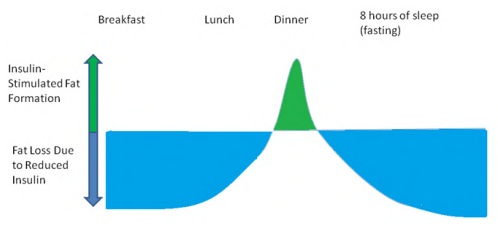What is Intermittent Fasting?
Intermittent fasting (IF) is a pattern of eating in which a person alternates between periods of eating and fasting. In this post, we’ll review the basics of IF, including if it works, the different methods, and how to apply it.
Does Intermittent Fasting Work?
You’re ALWAYS either storing body fat OR burning body fat. Never both at the same time.

When you eat, your insulin (fat storage hormone) is elevated.

When you fast, using either intermittent or OMAD, your insulin is low for a longer period and your body is able to tap into your body fat to burn for fuel.
These tactics, alongside a high-protein animal-based diet regimen and fasting-friendly workouts, this allows me and my clients to accelerate our fitness results.
And no, you WON’T be starving.
Fasting (when done right) stops your hunger completely.
The stomach growling isn’t true hunger, it’s just your blood sugar rising and falling.
When you’re fasting, your blood sugar stays steady, and you only get hungry when you’re actually hungry.
The other benefit is that research has shown that fasting helps retain more muscle than traditional calorie counting.
How so?
When your insulin is low because you’re fasting, your Human Growth Hormone levels are elevated. HGH preserves muscles and helps burn unwanted body fat.
Intermittent Fasting Methods
Time-restricted eating
In this option, you have set fasting and eating windows. For example, you fast for 16 hours of the day and only eat for eight hours of the day.
This method is popular because half of the fast happens while you sleep. It’s convenient as you extend the overnight fast by skipping breakfast and not eating until lunch. Here are some of the most common windows.
16/8 method: Only eating between 11 am and 7 pm or Noon and 8 pm.
OMAD: Only eating between one meal a day and fasting for the other 23 hours.
Finding the right eating and fasting windows for these methods might take a few days to figure out, especially if you are very active or wake up hungry for breakfast.
Twice-a-week method – 5:2
This approach to IF focuses on capping your calories at 500 for two days a week. During the other five days of the week, you maintain a healthy and normal diet.
On fasting days, the approach usually includes two 250 calorie meals. You will want to consume high-fiber, high-protein foods to keep calories low while keeping you full on these days.
You can choose whichever two fasting days as long as there is a non-fasting day between them. Be sure to eat your regular amount of food on non-fasting days.
Alternate day fasting
This variation involves fasting every other day. For instance, limit your calories on fasting days to 500 ― or about 25% of your normal intake. On non-fasting days, resume your regular, healthy diet. (There are also other variations to this approach that include consuming 0 calories on alternate days instead of 500.)
The 24-48-72 hour extended fasts
This method involves fasting for a full 24, 48, or 72 hours completely once a month or once a quarter.
If you follow this method, you should return to a normal, high protein, moderate fat diet on your non-fasting days.

